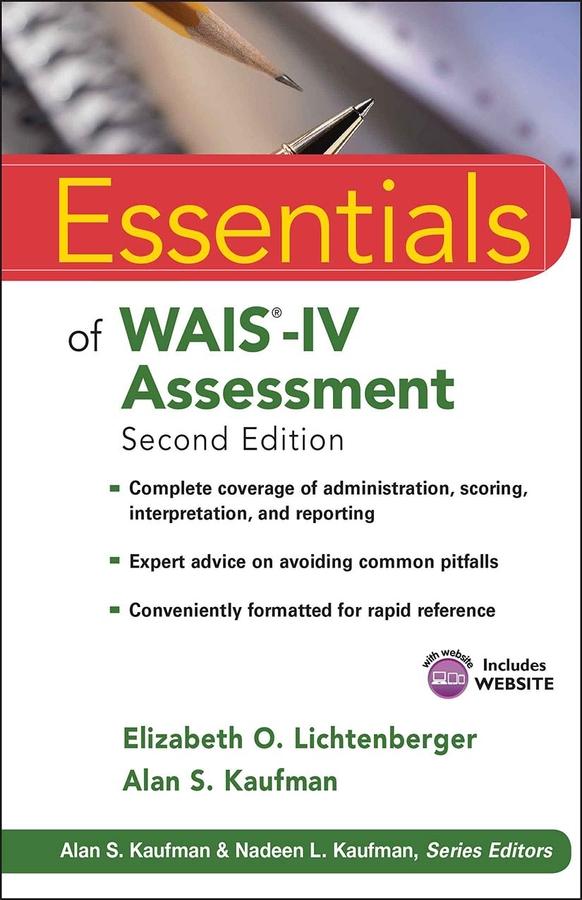
Zustellung: Mi, 28.05. - Di, 03.06.
Versand in 2 Wochen
VersandkostenfreiBestellen & in Filiale abholen:
Quickly acquire the knowledge and skills you need to confidently administer, score, and interpret the WAIS-IV.
Providing a clinically rich and innovative theory-based interpretive system, this book offers state-of-the-art interpretation of the most popular intelligence test for adults. In addition, the book is packaged with a CD-ROM containing scoring tables, case report material, worksheets, and a user-friendly software program that fully automates the interpretive system, making Essentials of WAIS-IV Assessment, Second Edition, the best and most authoritative resource of information on this test.
Updated with all of the new research, reviews, and interpretive guidelines:
* Incorporates new research findings on the psychometric quality and clinical utility of the WAIS-IV
* The interpretive system is greatly enhanced by offering the new five-factor CHC approach for ages 16-90 years
* Includes important new insights about administering and scoring subtests
* Includes new chapter on the latest WAIS-IV innovation--Q-interactive(TM)--that allows clinicians to administer WAIS-IV digitally
* Includes information about interpretation across different cultural and linguistic groups
* Provides important new coverage of the Flynn Effect
ABOUT THE CD-ROM
The updated CD-ROM contains scoring tables, case report material, worksheets, and a user-friendly software program that fully automates the interpretive system.
Providing a clinically rich and innovative theory-based interpretive system, this book offers state-of-the-art interpretation of the most popular intelligence test for adults. In addition, the book is packaged with a CD-ROM containing scoring tables, case report material, worksheets, and a user-friendly software program that fully automates the interpretive system, making Essentials of WAIS-IV Assessment, Second Edition, the best and most authoritative resource of information on this test.
Updated with all of the new research, reviews, and interpretive guidelines:
* Incorporates new research findings on the psychometric quality and clinical utility of the WAIS-IV
* The interpretive system is greatly enhanced by offering the new five-factor CHC approach for ages 16-90 years
* Includes important new insights about administering and scoring subtests
* Includes new chapter on the latest WAIS-IV innovation--Q-interactive(TM)--that allows clinicians to administer WAIS-IV digitally
* Includes information about interpretation across different cultural and linguistic groups
* Provides important new coverage of the Flynn Effect
ABOUT THE CD-ROM
The updated CD-ROM contains scoring tables, case report material, worksheets, and a user-friendly software program that fully automates the interpretive system.
Inhaltsverzeichnis
Series Preface xi
Preface to the Second Edition xiii
Acknowledgments xvii
One Introduction and Overview 1
Two How to Administer the WAIS-IV 53
Three How to Score the WAIS-IV 98
Four How to Interpret the WAIS-IV: Conceptual and Clinical Foundations 119
Five How to Interpret the WAIS-IV: Step-by-Step 150
Six Clinical Applications I: A Neuropsychological Approach to Interpretation of the WAIS-IV and the Use of the WAIS-IV in Learning Disability Assessments 216
George McCloskey, Emily S. Hartz, and Katherine Scipioni
Seven Clinical Applications II: Age and Intelligence Across the Adult Life Span 254
Eight Clinical Applications III: WAIS-IV Use With Special Groups, Practice Effects, and Gender Differences 299
Nine Strengths and Weaknesses of the WAIS-IV 332
Ron Dumont and John O. Willis
Ten Illustrative Case Reports 353
Eleven The Initial Digital Adaptation of the WAIS-IV 389
Tommie G. Cayton, Dustin Wahlstrom, and Mark H. Daniel
References 427
Annotated Bibliography 445
About the Authors 448
Author Index 449
Subject Index 455
About the CD-ROM 472
Preface to the Second Edition xiii
Acknowledgments xvii
One Introduction and Overview 1
Two How to Administer the WAIS-IV 53
Three How to Score the WAIS-IV 98
Four How to Interpret the WAIS-IV: Conceptual and Clinical Foundations 119
Five How to Interpret the WAIS-IV: Step-by-Step 150
Six Clinical Applications I: A Neuropsychological Approach to Interpretation of the WAIS-IV and the Use of the WAIS-IV in Learning Disability Assessments 216
George McCloskey, Emily S. Hartz, and Katherine Scipioni
Seven Clinical Applications II: Age and Intelligence Across the Adult Life Span 254
Eight Clinical Applications III: WAIS-IV Use With Special Groups, Practice Effects, and Gender Differences 299
Nine Strengths and Weaknesses of the WAIS-IV 332
Ron Dumont and John O. Willis
Ten Illustrative Case Reports 353
Eleven The Initial Digital Adaptation of the WAIS-IV 389
Tommie G. Cayton, Dustin Wahlstrom, and Mark H. Daniel
References 427
Annotated Bibliography 445
About the Authors 448
Author Index 449
Subject Index 455
About the CD-ROM 472
Produktdetails
Erscheinungsdatum
04. Dezember 2012
Sprache
englisch
Auflage
2nd edition
Seitenanzahl
512
Autor/Autorin
Elizabeth O Lichtenberger, Alan S. Kaufman
Herausgegeben von
Nadeen L Kaufman
Verlag/Hersteller
Produktart
kartoniert
Gewicht
592 g
Größe (L/B/H)
216/139/38 mm
ISBN
9781118271889
Entdecken Sie mehr
Bewertungen
0 Bewertungen
Es wurden noch keine Bewertungen abgegeben. Schreiben Sie die erste Bewertung zu "Essentials of Wais-IV Assessment" und helfen Sie damit anderen bei der Kaufentscheidung.










